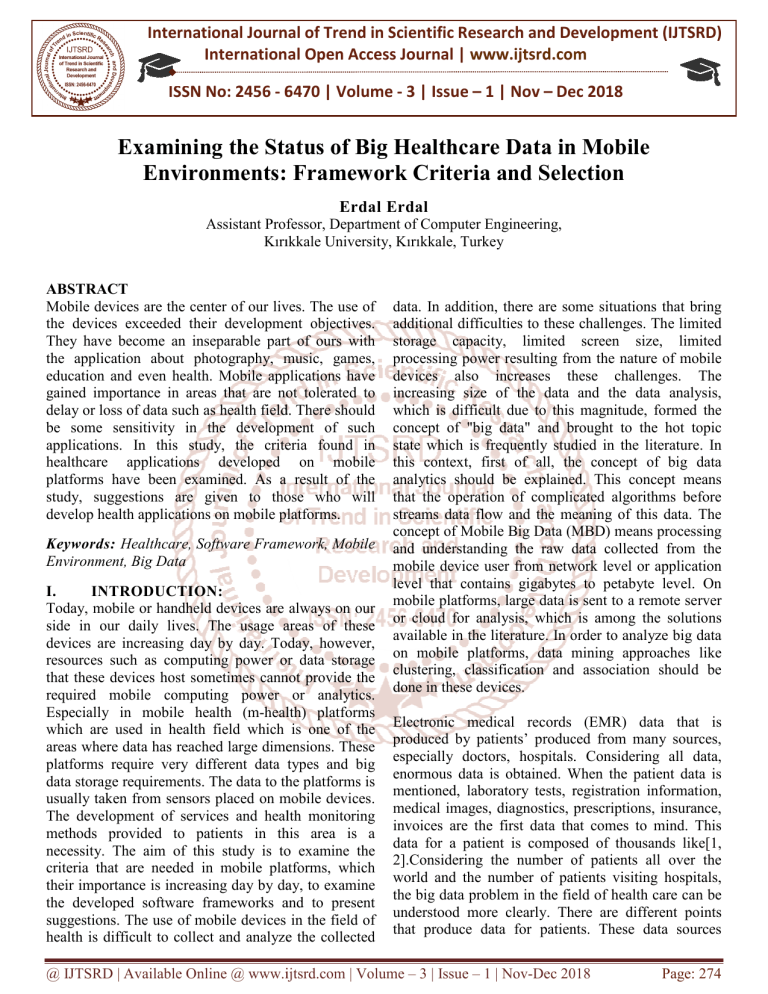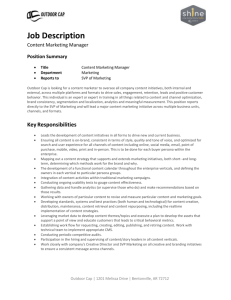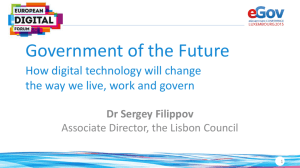
International Journal of Trend in Scientific Research and Development (IJTSRD)
International Open Access Journal | www.ijtsrd.com
ISSN No: 2456 - 6470 | Volume - 3 | Issue – 1 | Nov – Dec 2018
Examining the Status of Big Healthcare Data in
n Mobile
Environments:: Framework Criteria and
nd Selection
Erdal Erdal
Assistant Professor
Professor, Department of Computer Engineering,
Kırıkkale University
University, Kırıkkale, Turkey
ABSTRACT
Mobile devices are the center of our lives. The use of
the devices exceeded their development objectives.
They have become an inseparable part of ours with
the application about photography, music, games,
education andd even health. Mobile applications have
gained importance in areas that are not tolerated to
delay or loss of data such as health field. There should
be some sensitivity in the development of such
applications. In this study, the criteria found in
healthcare
re applications developed on mobile
platforms have been examined. As a result of the
study, suggestions are given to those who will
develop health applications on mobile platforms.
Keywords: Healthcare, Software Framework, Mobile
Environment, Big Data
I.
INTRODUCTION:
Today, mobile or handheld devices are always on our
side in our daily lives. The usage areas of these
devices are increasing day by day. Today, however,
resources such as computing power or data storage
that these devices host sometimes canno
cannot provide the
required mobile computing power or analytics.
Especially in mobile health (m-health)
health) platforms
which are used in health field which is one of the
areas where data has reached large dimensions. These
platforms require very different data types and big
data storage requirements. The data to the platforms is
usually taken from sensors placed on mobile devices.
The development of services and health monitoring
methods provided to patients in this area is a
necessity. The aim of this study is to ex
examine the
criteria that are needed in mobile platforms, which
their importance is increasing day by day, to examine
the developed software frameworks and to present
suggestions. The use of mobile devices in the field of
health is difficult to collect and analyze
nalyze the collected
data. In addition, there are some situations that bring
additional difficulties to these challenges. The limited
storage capacity, limited screen size, limited
processing power resulting from the nature of mobile
devices also increases
es these challenges. The
increasing size of the data and the data analysis,
which is difficult due to this magnitude, formed the
concept of "big data" and brought to the hot topic
state which is frequently studied in the literature. In
this context, first of all, the concept of big data
analytics should be explained. This concept means
that the operation of complicated algorithms before
streams data flow and the meaning of this data. The
concept of Mobile Big Data (MBD) means processing
and understanding the raw data collected from the
mobile device user from network level or application
level that contains gigabytes to petabyte level. On
mobile platforms, large data is sent to a remote server
or cloud for analysis, which is among the solutions
available in the literature. In order to analyze big data
on mobile platforms, data mining approaches like
clustering, classification and association should be
done in these devices.
Electronic medical records (EMR) data that is
produced by patients’ produced from many
m
sources,
especially doctors, hospitals. Considering all data,
enormous data is obtained. When the patient data is
mentioned, laboratory tests, registration information,
medical images, diagnostics, prescriptions, insurance,
invoices are the first data that comes to mind. This
data for a patient is composed of thousands like[1,
like
2].Considering
.Considering the number of patients all over the
world and the number of patients visiting hospitals,
the big data problem in the field of health care can be
understood
tood more clearly. There are different points
that produce data for patients. These data sources
@ IJTSRD | Available Online @ www.ijtsrd.com | Volume – 3 | Issue – 1 | Nov-Dec
Dec 2018
Page: 274
International Journal of Trend in Scientific Research and Development (IJTSRD) ISSN: 2456-6470
2456
include wearable sensors, smart phones and social
media resources. These data are of great importance
for doctors and hospitals, as they provide cross
crosssections of patients' daily lives. These devices
regulate the patient's sleep, record heartbeat, ECG,
body temperature, pulse, and location. Sharing the
produced data with stakeholders is another challenge.
However, such data may be regarded as raw data.
There is an analysis requirement for data to be
meaningful. Continuous follow-up
up of patients is
constantly evolving with better sensors and better
analysis techniques. The targeted method of 3M
health strategy across the world is based on patient
data Monitor, Measure,
ure, and Manage concepts
concepts[3].
The aim of this study is to examine the status of large
health data in mobile
ile environments and to present the
criteria needed in this field. In addition,
recommendations are made for software frameworks
to be developed in this area.
II.
LITERATURE REVIEW
This part of the study includes studies in the literature.
In 2013, Zaslavsky et al. make a study by mobile
analytics categorized into categories[4].. In this study,
cloud communication and communication areas of the
systems in mobile devices are discussed. In this study,
an architecture has been proposed to collect, manage
and process thee data flow on mobile devices. As a
result of this study, bandwidth and energy savings
were obtained in mobile devices.
There are different tools for processing and analyzing
data on mobile devices[5].. In the literature, a mobile
phone toolkit called Incense collects behavioral data
with the information it obtains from its users. In
addition to such tools, there are studies aiming at
optimizing resources
sources such as decision making,
battery, bandwidth, storage in literature. It supports
the situation-aware and resource-aware
aware approaches
with its hybrid design which is equipped with a tool
called Mobile miner suitable for mobile devices
devices[6].A
Spark-based
based software framework has also been
proposed for managing and analyzing large data on
mobile devices[7].However,
.However, some restrictions on
mobile devices prevent their use for such purposes.
These restrictions can be listed as storage, energy
problems and memory. Due to these restrictions,
heavy data mining operations cannot be performed on
mobile devices. However,, algorithms that operate on
small data sets, which provide energy efficiency,
work on mobile devices. In the literature, studies are
also carried out in this field. For example, a
distributed task management approach has been
proposed in a study. In the study, an architecture was
developed based on the data mining clustering that
should be processed in the mobile nodes[8].Advanced
nodes
machine learning and data analysis techniques have
been proposed to improve energy efficiency in mobile
and IoT devices[9].With
.With these criteria, cellular
networks-specific
specific algorithms are needed to analyze
large-scale
scale mobile data on mobile devices. In this
way, mobile service providers can provide customers
with special services and opportunities[10].An
opportunities
architecture that regulates the use of resources in
terms of energy consumption has been developed on
cloud computing[11].
III.
CRITERIA
The software framework for managing health data on
mobile platforms should have some criteria. These
criteria are as follows: Energy optimization, data
offloading, sensor data management, mobile analytics,
mobile app integration and data customization. What
Wha
this criterion means is examined at this part of the
study.
A. Energy optimization
The importance of energy in the world is
increasing day by day. Therefore, energy
optimization is one of the important issues
discussed in the literature today. Therefore, it is
one of the indispensable criteria for the processing
of health services data on mobile platforms.
B. Data off loading
With data offloading, the amount of data carried
on the cellular network is reduced and the
bandwidth that can be used by other users is
released. It is a term that can be used not only for
wireless connections but also for wired
connections if needed.
C. Sensor data management
With the developing technology, the concept of
IoT has entered our lives. This concept is based on
the flow of data from all objects. Another criterion
for devices such as mobile devices that are always
near us is that they support reading data from the
sensors. In other words, the sensory data must be
processed and can be collected.
D. Mobile analytics and customization
Mobile devices need to support mobile analytics
in order to reduce the energy consumption and
optimize the bandwidth. Otherwise, both the
bandwidth
dwidth and the energy consumption are
@ IJTSRD | Available Online @ www.ijtsrd.com | Volume – 3 | Issue – 1 | Nov-Dec
Dec 2018
Page: 275
International Journal of Trend in Scientific Research and Development (IJTSRD) ISSN: 2456-6470
2456
required to transfer all the collected data to the
cloud or to another location.
criterion of the system to be developed is very
important for end users.
E. Mobile app integration
Today, mobile
bile devices interact with devices used
for different purposes. These devices include
televisions, smart watches, smart glasses. For this
reason, integration with other devices or
applications is required in all studies.
In addition, the processing of the collected and
processed data at the appropriate time is necessary
in order not to affect the end user. Mobile
analytics should not be performed in situations
where the energy level or bandwidth of the mobile
device is not appropriate. Considering this
[4]
Energy
optimization
√
Data ooff
ff
loading
✗
Sensor data
management
√
Mobile analytics and
customization
√
Mobile app
integration
√
[5]
✗
✗
√
√
✗
[7]
✗
✗
√
✗
[8]
✗
√
✗
✗
√
✗
[11]
√
✗
✗
✗
[12]
√
✗
√
✗
✗
✗
[13]
✗
√
✗
✗
✗
[14]
✗
√
✗
Table1. Current literature
✗
✗
Reference
Table 1 shows the details of the studies in the
literature according to the criteria. As shown in the
table, the studies in the literature focused on different
criteria.
IV.
SUGGESTIONS
In this study, the criteria for the systems developed for
mobile platforms are listed. The criteria are explained
in detail and the studies in this area are examined in
the literature and the criteria which are found in Table
1.
In this respect, the following recommendations are
presented.
The energy optimization problem, which is
important in all applications developed on mobile
platforms, is also very important in the process of
data processing.
Bandwidth, which is one of the restrictions on
mobile platforms, is a serious problem for devices
using cellular networks. In addition, the
importance of bandwidth increases with IoT.
Therefore, data should be taken into consideration
in all systems to be developed.
With the developing technology, the concept of
IoT stretched into our lives. Reading the data
received from the sensors by the mobile devices
that are always with us is hot topic in the
literature. Therefore, the systems to be developed
must be capable of reading data from the sensors.
Sending all data to the cloud or another device on
mobile devices has problems in terms of energy or
mobile data used. Therefore, it is the most optimal
way to process and analyze the data obtained in
the device. However, this process should be done
in the best time and the end user is least affected.
For this reason, customization must be enabled in
the systems to be developed.
The importance of mobile applications in mobile
applications has increased. Mobile application
ap
integration infrastructure must be prepared in the
systems developed for sharing the obtained data
with different applications.
V.
CONCLUSION
The mobile devices that we use in every area of our
lives are also frequently used in healthcare. In this
study, new technology trends in health services
systems and applications are examined and
recommendations are presented. This list contains the
criteria for health applications developed for mobile
devices. The study is a guide for the applications for
the health field.
@ IJTSRD | Available Online @ www.ijtsrd.com | Volume – 3 | Issue – 1 | Nov-Dec
Dec 2018
Page: 276
International Journal of Trend in Scientific Research and Development (IJTSRD) ISSN: 2456-6470
2456
REFERENCES
1. Liu, W. and E. K. Park, Big Data as an ee-Health
Service. 2014: p. 982-988.
8. Comito, C., et al., A Distributed Allocation
Al
Strategy for Data Mining Tasks in Mobile
Environments. 2013. 446:: p. 231-240.
231
2. Pramanik, M. I., et al., Smart health: Big data
enabled health paradigm within smart cities.
Expert Systems with Applications, 2017. 87: p.
370-383.
9. Pasricha, S., Overcoming Energy and Reliability
Challenges for IoT and Mobile Devices with Data
Analytics. 2018: p. 238-243.
243.
3. Schatz, B. R., National Surveys of Population
Health: Big Data Analytics for Mobile Health
Monitors. Big Data, 2015. 3(4):
(4): p. 219
219-229.
4. Zaslavsky, A., P. P. Jayaraman, and S.
Krishnaswamy,
ShareLikesCrowd:
Mobile
analytics for participatory sensing
sing and crowd
crowdsourcing applications. 2013: p. 128--135.
5. Castro, L. A., et al., Collaborative opportunistic
sensing with mobile phones. 2014: p. 1265
1265-1272.
6. Haghighi, P. D., et al., Open Mobile Miner: A
Toolkit for Building Situation-Aware
Aware Data Mining
Applications.
Journal
of
Organizational
Computing and Electronic Commerce, 2013.
23(3): p. 224-248.
7. Alsheikh, M. A., et al., Mobile big data analytics
using deep learning and apache spark. IEEE
Network, 2016. 30(3): p. 22-29.
10. He, Y., et al., Big Data Analytics in Mobile
Cellular Networks. IEEE Access, 2016. 4: p.
1985-1996.
11. Alzamil, I., et al., Energy-Aware
Energy
Profiling for
Cloud Computing Environments. Electronic Notes
in Theoretical Computer Science, 2015. 318: p.
91-108.
12. Sarathchandra Magurawalage, C. M., et al.,
Energy-efficient
efficient and network-aware
network
offloading
algorithm for mobile cloud computing. Computer
Networks, 2014. 74: p. 22--33.
13. Tan, A. S. and E. Zeydan, Performance
maximization of network assisted mobile data
offloading with opportunistic Device-to-Device
Device
communications. Computer Networks, 2018. 141:
p. 31-43.
14. Hayat, R., et al., Modeling and evaluating a
cloudlet-based
based architecture for Mobile Cloud
Computing in 2014 9th International Conference
on Intelligent Systems: Theories and Applications
(SITA-14) 2014,
4, IEEE Rabat, Morocco
@ IJTSRD | Available Online @ www.ijtsrd.com | Volume – 2 | Issue – 6 | Sep-Oct
Oct 2018
Page: 277



